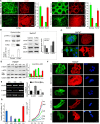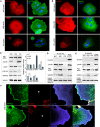Tumor promotion by γ and suppression by β non-muscle actin isoforms
- PMID: 26008973
- PMCID: PMC4546487
- DOI: 10.18632/oncotarget.3989
Tumor promotion by γ and suppression by β non-muscle actin isoforms
Abstract
Here we have shown that β-cytoplasmic actin acts as a tumor suppressor, inhibiting cell growth and invasion in vitro and tumor growth in vivo. In contrast, γ-cytoplasmic actin increases the oncogenic potential via ERK1/2, p34-Arc, WAVE2, cofilin1, PP1 and other regulatory proteins. There is a positive feedback loop between γ-actin expression and ERK1/2 activation. We conclude that non-muscle actin isoforms should not be considered as merely housekeeping proteins and the β/γ-actins ratio can be used as an oncogenic marker at least for lung and colon carcinomas. Agents that increase β- and/or decrease γ-actin expression may be useful for anticancer therapy.
Keywords: ERK1/2; PP1; WAVE; actin isoforms; cancer; cofilin1; p34-Arc.
Conflict of interest statement
Authors do not have any conflicts of interests.
Figures








Similar articles
-
Actin-regulated feedback loop based on Phactr4, PP1 and cofilin maintains the actin monomer pool.J Cell Sci. 2013 Jan 15;126(Pt 2):497-507. doi: 10.1242/jcs.113241. Epub 2012 Nov 30. J Cell Sci. 2013. PMID: 23203801
-
Active invadopodia of mesenchymally migrating cancer cells contain both β and γ cytoplasmic actin isoforms.Exp Cell Res. 2015 Dec 10;339(2):206-19. doi: 10.1016/j.yexcr.2015.11.003. Epub 2015 Nov 5. Exp Cell Res. 2015. PMID: 26548725
-
Suppression of FHL2 expression induces cell differentiation and inhibits gastric and colon carcinogenesis.Gastroenterology. 2007 Mar;132(3):1066-76. doi: 10.1053/j.gastro.2006.12.004. Epub 2006 Dec 3. Gastroenterology. 2007. PMID: 17383428
-
Biology of Krüppel-like factor 6 transcriptional regulator in cell life and death.IUBMB Life. 2010 Dec;62(12):896-905. doi: 10.1002/iub.396. IUBMB Life. 2010. PMID: 21154818 Review.
-
The Cytoplasmic Actins in the Regulation of Endothelial Cell Function.Int J Mol Sci. 2021 Jul 22;22(15):7836. doi: 10.3390/ijms22157836. Int J Mol Sci. 2021. PMID: 34360602 Free PMC article. Review.
Cited by
-
Interaction of microtubules with the actin cytoskeleton via cross-talk of EB1-containing +TIPs and γ-actin in epithelial cells.Oncotarget. 2016 Nov 8;7(45):72699-72715. doi: 10.18632/oncotarget.12236. Oncotarget. 2016. PMID: 27683037 Free PMC article.
-
Common housekeeping proteins are upregulated in colorectal adenocarcinoma and hepatocellular carcinoma, making the total protein a better "housekeeper".Oncotarget. 2016 Oct 11;7(41):66679-66688. doi: 10.18632/oncotarget.11439. Oncotarget. 2016. PMID: 27556505 Free PMC article.
-
Variants in exons 5 and 6 of ACTB cause syndromic thrombocytopenia.Nat Commun. 2018 Oct 12;9(1):4250. doi: 10.1038/s41467-018-06713-0. Nat Commun. 2018. PMID: 30315159 Free PMC article.
-
Myosin Va plays essential roles in maintaining normal mitosis, enhancing tumor cell motility and viability.Oncotarget. 2017 May 17;8(33):54654-54671. doi: 10.18632/oncotarget.17920. eCollection 2017 Aug 15. Oncotarget. 2017. PMID: 28903372 Free PMC article.
-
Loss of β-Cytoplasmic Actin in the Intestinal Epithelium Increases Gut Barrier Permeability in vivo and Exaggerates the Severity of Experimental Colitis.Front Cell Dev Biol. 2020 Oct 23;8:588836. doi: 10.3389/fcell.2020.588836. eCollection 2020. Front Cell Dev Biol. 2020. PMID: 33195251 Free PMC article.
References
-
- Vandekerckhove J, Weber K. At least six different actins are expressed in a higher mammal: an analysis based on the amino acid sequence of the amino-terminal tryptic peptide. J Mol Biol. 1978;126:783–802. - PubMed
-
- Rubenstein PA. The functional importance of multiple actin isoforms. Bioessays. 1990;12:309–315. - PubMed
-
- Harborth J, Elbashir SM, Bechert K, Tuschl T, Weber K. Identification of essential genes in cultured mammalian cells using small interfering RNAs. J Cell Sci. 2001;114:4557–4565. - PubMed
-
- Khaitlina SY. Functional specificity of actin isoforms. Int Rev Cytol. 2001;202:35–98. - PubMed
Publication types
MeSH terms
Substances
LinkOut - more resources
Full Text Sources
Other Literature Sources
Miscellaneous

